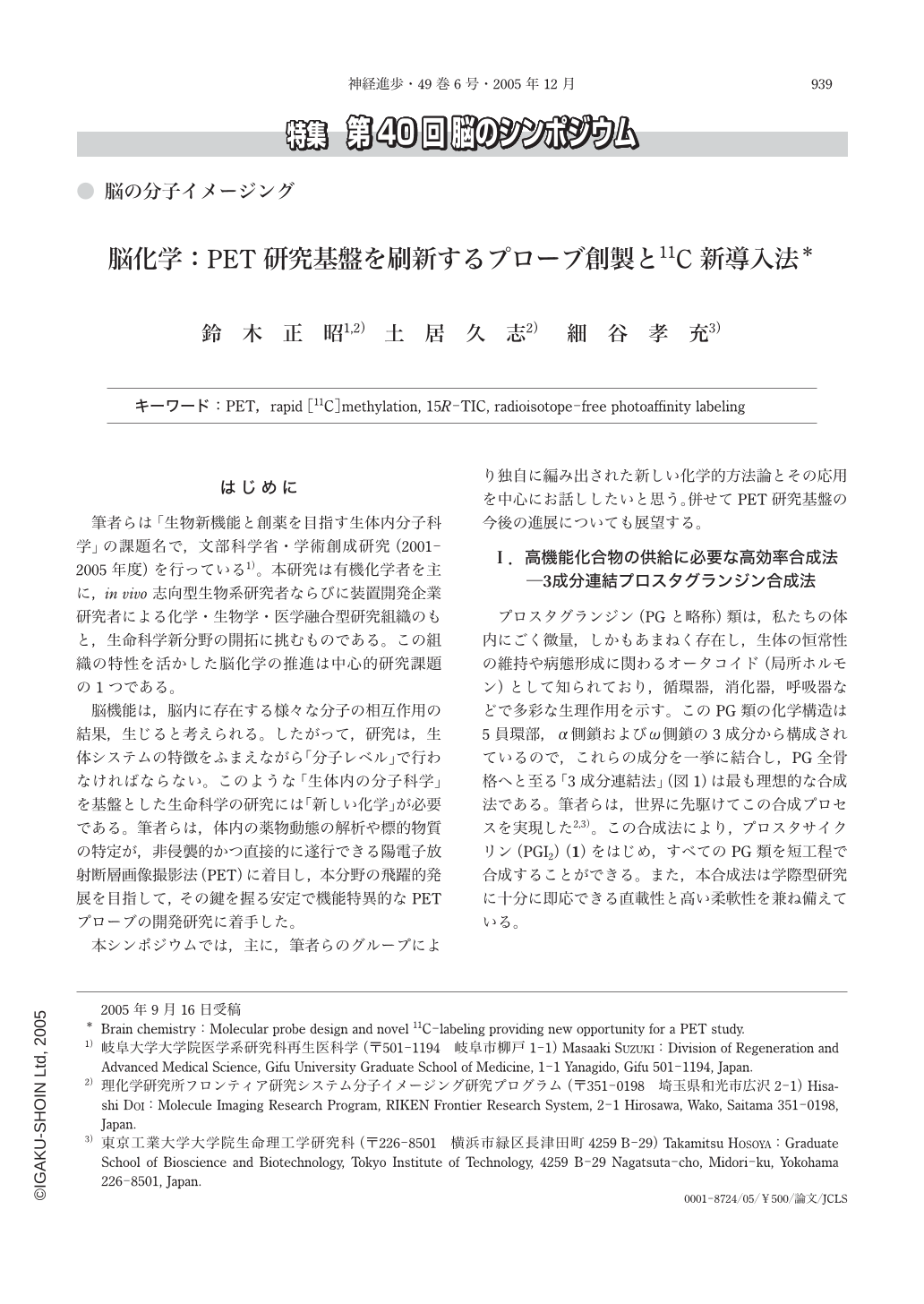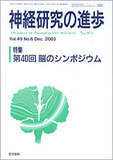Japanese
English
- 有料閲覧
- Abstract 文献概要
- 1ページ目 Look Inside
筆者らは「生物新機能と創薬を目指す生体内分子科学」の課題名で,文部科学省・学術創成研究(2001-2005年度)を行っている1)。本研究は有機化学者を主に,in vivo 志向型生物系研究者ならびに装置開発企業研究者による化学・生物学・医学融合型研究組織のもと,生命科学新分野の開拓に挑むものである。この組織の特性を活かした脳化学の推進は中心的研究課題の1つである。
脳機能は,脳内に存在する様々な分子の相互作用の結果,生じると考えられる。したがって,研究は,生体システムの特徴をふまえながら「分子レベル」で行わなければならない。このような「生体内の分子科学」を基盤とした生命科学の研究には「新しい化学」が必要である。筆者らは,体内の薬物動態の解析や標的物質の特定が,非侵襲的かつ直接的に遂行できる陽電子放射断層画像撮影法(PET)に着目し,本分野の飛躍的発展を目指して,その鍵を握る安定で機能特異的なPETプローブの開発研究に着手した。
本シンポジウムでは,主に,筆者らのグループにより独自に編み出された新しい化学的方法論とその応用を中心にお話ししたいと思う。併せてPET研究基盤の今後の進展についても展望する。
Positron emission tomography(PET)is a particularly powerful noninvasive method for the investigation of in vivo biochemistry, especially in the human organ. The need for the development of new PET tracers has grown with the increase in the use of this technique in medicine. In this context, we recently developed 15R-TIC(2), a prostaglandin ligand, which selectively binds with a prostacyclin receptor(IP2)in the central nervous system. The tolyl group in 2 was intended as a trigger component to create a 11C-incorporated radioligand for molecular imaging. We have been obliged to develop new method to introduce a short-lived 11C nuclide into an organic framework. Thus, we have succeeded in developing a rapid coupling of methyl iodide with an arytributylstannane(excess)in the presence of a tri-o-tolylphosphine-bound coordinatively unsaturated Pd(0)complex, a Cu(I)salt, and K2CO3. This protocol has been successfully applied to the synthesis of 15R-[11C]TIC methyl ester(3), a PET tracer targeting IP2. A PET studies of monkey has been conducted by intravenous injection to visualize IP2 in the brains. Thus, a high uptake of 3 into the brain takes place and the local imaging has been observed in the thalamus, striatum, and temporal cortex. By comparing with the different behavior of the tracer labeled at the ester moiety, we have found that the methyl ester derivative 3 penetrates the blood-brain-barrier and then undergoes rapid enzymatic hydrolysis of the ester to produce 15R-[11C]TIC([11C]-2), which binds to the IP2 receptor in the brain.
This novel[11C]methylation has several benefits. The C-11CH3 group is highly metabolically stable in comparison with N-11CH3, O-11CH3, and S-11CH3 ones, and therefore, the resulting image is highly credible. The methyl group is a minimum carbon substituent and non-polar, which causes a little change in the function of a PET tracer seed compound. Thus, the molecular design of a PET tracer would be possible within a predictable realm. We have been expanding the rapid methyaltion to alkyne, alkene, and alkane in order to realize highly flexible incorporation of a 11CH3 group into organic molecules. These protocols are also useful for the incorporation of other carbon isotope units such as 13CH3, 14CH3, and CD3 for the metabolic study. The incorporation of 14CH3 group would particularly be useful for a study on the long-term drug metabolism by microdosing using AMS(Accelerator Mass Spectrometry).
In addition, we have developed a novel method for radioisotope-free photoaffinity labeling. A photoaffinity probe is comprised of compact reactive bifunctional groups. One is used for the connection with a target protein by photo-activation and another is for the detection of the captured protein by a chemical reaction using a reactant with detectable functions such as fluorescent structure and biotin. The utility of this method has been demonstrated by specific labeling of the catalytic portion of human HMG-CoA reductase and a protein(<29 kDa)involved in the E-C coupling of skeletal muscle.

Copyright © 2005, Igaku-Shoin Ltd. All rights reserved.


